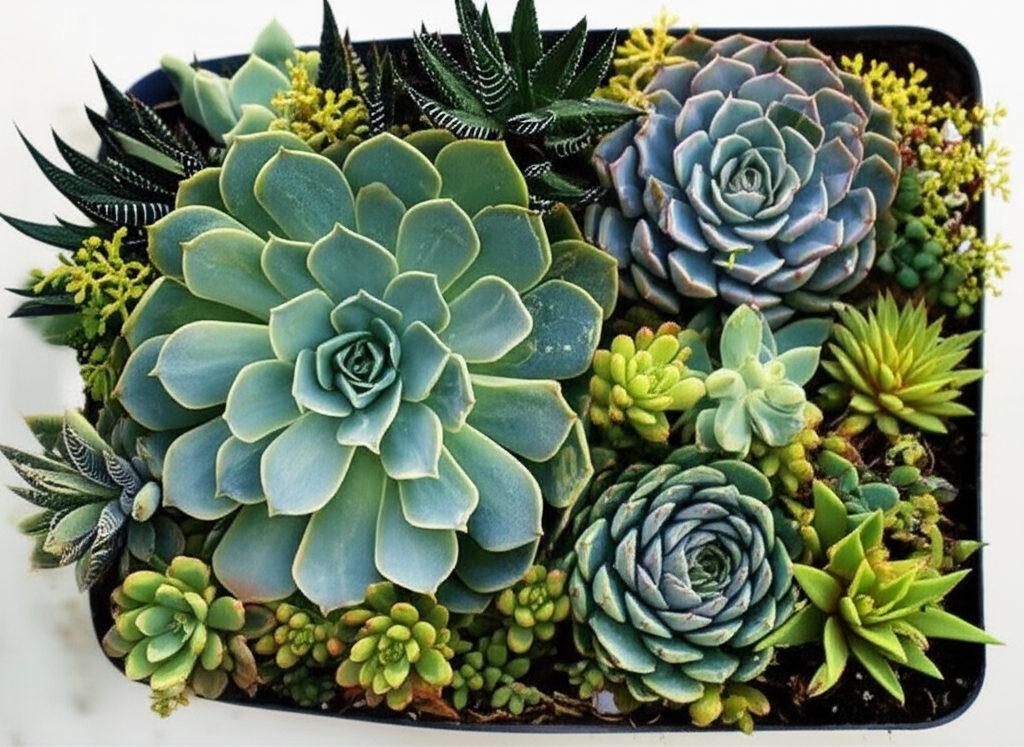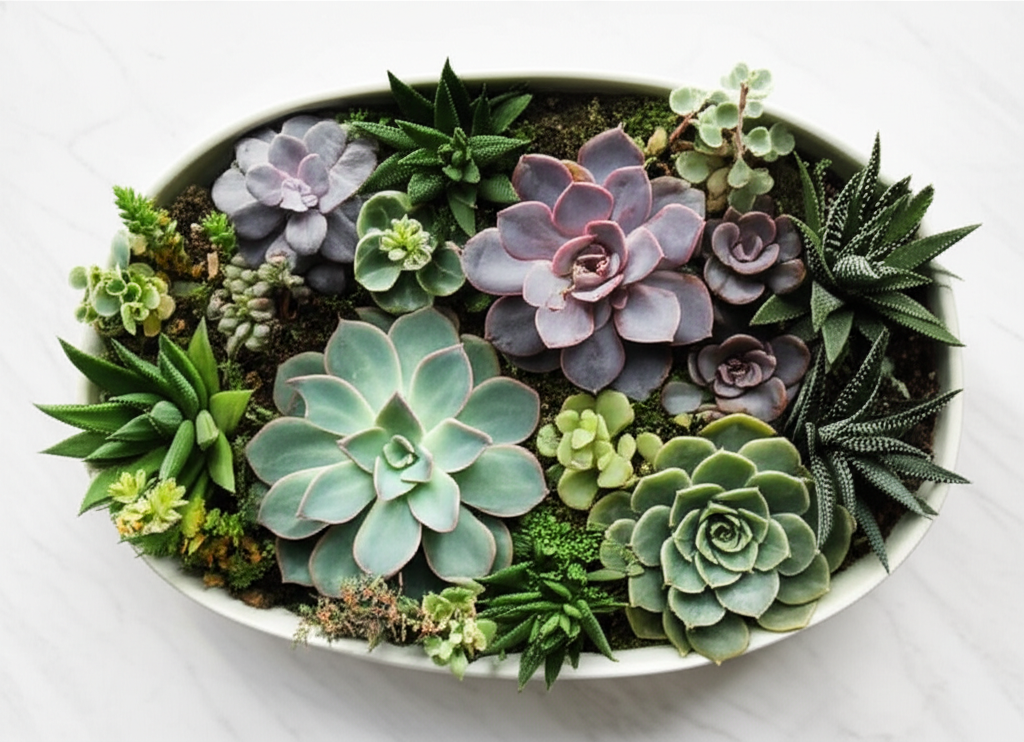Introduction to the Allure of Ice Plant Succulents
The world of succulents offers an endless array of fascinating forms and textures, but few capture the imagination quite like the Ice Plant family, scientifically known as Mesembryanthemaceae. These remarkable plants are celebrated for their unique epidermal cells, known as hydathodes or papillae, which can resemble droplets of water or ice crystals, giving them their evocative common name. Beyond their captivating appearance, ice plants are renowned for their resilience, adaptability, and the surprisingly vibrant blooms they often produce.
Creating a tabletop garden with ice plant succulents is an excellent way to bring a touch of natural wonder and vibrant color into your living space. These small-scale arrangements are perfect for desks, windowsills, coffee tables, and even kitchen countertops, offering a dynamic and evolving display of living art. This guide will delve into various arrangement ideas, focusing on aesthetics, care, and how to create a miniature ecosystem that thrives.
Why Choose Ice Plants for Tabletop Gardens?
Ice plants offer a unique combination of desirable traits that make them ideal for small-scale, indoor gardening:
- Unique Aesthetic: The “ice” or “dew” covering on many species provides an unparalleled visual appeal, setting them apart from more common succulents.
- Compact Growth Habits: Many ice plant varieties naturally grow in a low, spreading, or clumping fashion, making them perfectly suited for contained environments.
- Drought Tolerance: Like most succulents, they are exceptionally drought-tolerant, forgiving of occasional neglect and requiring minimal watering.
- Vibrant Blooms: Many species produce profuse and brilliantly colored flowers, often in shades of pink, yellow, orange, and white, adding seasonal bursts of joy to your arrangement.
- Low Maintenance: With the right conditions, ice plant tabletop gardens are incredibly low-maintenance, perfect for busy individuals or novice gardeners.
- Variety of Textures and Forms: From smooth, pebble-like leaves to fringed or spiky structures, the diversity within the Mesembryanthemaceae family is astounding.
Understanding Key Ice Plant Varieties for Tabletop Gardens

Before diving into arrangement ideas, it’s crucial to understand some popular and suitable ice plant species. Each brings a distinct character to a miniature garden.
Popular Ice Plant Species and Their Characteristics
| Species Name | Common Name | Key Features | Ideal for Tabletop Gardens |
|---|---|---|---|
| Delosperma cooperi | Cooper’s Ice Plant | Bright purple-pink daisy-like flowers; succulent, finger-like leaves. Low-growing and spreading. | Excellent for trailing or spilling over pot edges. |
| Lithops spp. | Living Stones | Bodiees resembling pebbles or stones; incredible camouflage. Striking flowers emerge from the top fissure. | Fascinating focal points, best kept with similar drought-tolerant, slow-growing companions. |
| Fenestraria rhopalophylla | Baby Toes | Short, fleshy, finger-like leaves with transparent “windows” at the tips. White or yellow flowers. | Adds a unique, almost alien texture. Needs good drainage. |
| Conophytum spp. | Pebble Plants | Tiny, often paired, succulent leaves resembling small pebbles. Numerous, often star-shaped flowers. | Ideal for very small, detailed arrangements or fairy gardens. |
| Gibbaeum album | White Gibbaeum | Opposite pairs of fleshy leaves that can appear slightly flattened or rounded. Usually solitary white flowers. | Offers a more subtle, sculptural form. |
| Aptenia cordifolia | Hearts and Flowers Ice Plant | Heart-shaped, fleshy leaves and small, magenta flowers. Vigorous, trailing growth. | Great for cascading arrangements, but can be fast-growing. |
Essential Elements for a Thriving Tabletop Garden
Successful ice plant tabletop gardens are built on a foundation of proper care and the right materials.
Containers and Drainage
The choice of container is paramount for succulents. They demand excellent drainage to prevent root rot.
- Material: Unglazed terracotta is often ideal as it allows for better airflow and moisture evaporation. Ceramic and glass can also be used, but require more attention to watering.
- Drainage Holes: This is non-negotiable. Ensure your chosen container has at least one drainage hole. If using a decorative pot without a hole, employ it as a cachepot, placing a smaller pot with drainage inside.
- Size: Select a container that is proportionate to the plants. Too large a pot can hold excess moisture, while too small can restrict growth. A shallow, wide bowl or a small trough is often perfect for succulent arrangements.
Soil Mix
A specialized succulent and cactus mix is essential. Standard potting soil retains too much moisture.
- Components: A good mix typically includes coarse sand, perlite, pumice, and a small amount of organic matter.
- DIY Mix: You can create your own by combining equal parts potting soil, coarse sand, and perlite or pumice.
- Enhancing Drainage: For very sensitive plants like Lithops, consider increasing the grit content even further.
Light Requirements
Most ice plants thrive in bright, indirect sunlight.
- Indoors: A south or west-facing window is generally ideal. If natural light is insufficient, consider using a grow light.
- Signs of Inadequate Light: Plants may become leggy (etiolated) and stretch towards the light source, losing their compact form.
- Signs of Too Much Intense Sun: Some varieties can develop red or brown stress coloring, which can be desirable but excessive scorching should be avoided.
Watering and Fertilizing
Proper watering is key to succulent health.
- Watering Frequency: Water thoroughly only when the soil is completely dry. This might be every few weeks, depending on the environment, season, and plant type.
- How to Water: Water the soil directly, avoiding the plant’s bodies, especially with ‘Living Stones’ to prevent rot.
- Fertilizing: Ice plants are not heavy feeders. Use a diluted succulent or cactus fertilizer sparingly during the growing season (spring and summer), perhaps once or twice.
Creative Tabletop Garden Arrangement Ideas
Now, let’s explore some inspiring ways to arrange your ice plant succulents.
1. The “Living Pebbles” Diorama
This arrangement focuses on the fascinating, rock-like appearance of species like Lithops and Conophytum.
Concept:
Mimic a miniature desert landscape where the plants are the stars, disguised as natural stones.
Materials:
- Various Lithops and Conophytum species.
- A shallow, wide ceramic or terracotta bowl.
- Gritty, well-draining soil mix.
- Small decorative pebbles, gravel, or coarse sand for top dressing.
- Optional: A few small, weathered rocks or pieces of driftwood for added texture.
Arrangement Steps:
- Prepare the container with a generous layer of the gritty soil mix.
- Gently remove the “living stones” from their nursery pots, being careful not to disturb the roots too much.
- Arrange the plants, spacing them appropriately to allow for their slow growth. Place larger specimens towards the back or center.
- Fill in any gaps with more soil mix, ensuring the tops of the plants are not buried.
- Apply a top dressing of fine gravel or sand, leaving the visible parts of the plant bodies exposed. This mimics their natural environment and aids in drainage.
- Add any decorative rocks or driftwood.
Care Notes:
- Water extremely sparingly, allowing the soil to dry out completely between waterings. Lithops often have dormancy periods where watering should be ceased entirely.
- Provide plenty of bright light.
2. The “Dewy Meadow” Cascading Arrangement
This idea utilizes the trailing and spreading habits of species like Delosperma and Aptenia.
Concept:
Create a vibrant, cascading effect that spills over the edges of a container, resembling a miniature waterfall of succulent foliage and flowers.
Materials:
- Delosperma cooperi (for purple flowers).
- Aptenia cordifolia (for pink flowers and heart-shaped leaves).
- Potentially a low-growing, clumping ice plant like Conophytum for contrast in the center.
- A hanging basket, a tall pot, or a container with a rim that allows for trailing.
- Succulent soil mix.
- Optional: Small decorative stones or polished river rocks for the top.
Arrangement Steps:
- If using a hanging basket or tall pot, add a layer of gravel at the bottom for added drainage (though good soil is more important).
- Fill the container with the succulent soil mix.
- Plant the trailing varieties around the edges of the container, allowing their stems to hang over.
- Place any clumping varieties towards the center or as focal points.
- Water lightly after planting to help the roots establish.
- As the plants grow, gently guide the trailing stems over the edges.
Care Notes:
- These varieties generally appreciate more light than Lithops but still need excellent drainage.
- Water when the top inch of soil is dry.
- Prune as needed to maintain shape and encourage bushier growth.
3. The “Textural Tapestry” Mixed Arrangement
This arrangement focuses on combining different forms and textures of ice plants for a visually rich display.
Concept:
Create a dynamic composition using a variety of ice plant species, playing with heights, textures, and colors.
Materials:
- A mix of ice plant species: e.g., Lithops (for form), Delosperma (for color and trailing), Fenestraria (for unique texture), and perhaps a spikier Mesembryanthemum for contrast.
- A shallow, wide container or a small trough.
- Well-draining succulent soil.
- Top dressing: small gravel, pumice, or decorative sand.
- Optional: A single striking rock or piece of driftwood as a centerpiece.
Arrangement Steps:
- Plan your layout before planting. Consider the mature size and growth habit of each plant.
- Fill the container with soil, creating gentle mounds and depressions to add visual interest.
- Start planting from the back or center, placing taller or more upright plants first.
- Incorporate trailing or lower-growing varieties around the edges and in the foreground.
- Position plants with contrasting textures and colors next to each other. For example, smooth Lithops next to the “windowed” Fenestraria.
- Add your centerpiece if using.
- Apply a top dressing to cover the soil surface, enhancing the aesthetic and aiding drainage.
- Water lightly to settle the soil.
Care Notes:
- The watering needs of mixed arrangements can be tricky if plants have very different requirements. In this case, err on the side of under-watering. Group plants with similar needs if possible.
- Ensure all plants receive adequate bright light.
Maintenance and Troubleshooting for Your Tabletop Garden
Even the most beautiful arrangements require a little attention to thrive.
Seasonal Care Adjustments
Ice plants, like most succulents, have periods of dormancy and active growth.
- Spring/Summer (Growing Season): Increase light exposure. Water more frequently as the soil dries out, but always check for dryness first. Fertilize sparingly.
- Autumn/Winter (Dormancy/Reduced Growth): Reduce watering significantly. Provide as much light as possible. Avoid fertilizing. Some species may enter a resting period where they lose leaves or change appearance.
Common Issues and Solutions
| Problem | Cause | Solution |
|---|---|---|
| Root Rot | Overwatering, poor drainage. | Allow soil to dry completely between waterings. Ensure adequate drainage holes. Repot in drier, grittier soil if severe. |
| Etiolation (Stretching) | Insufficient light. | Move plants to a brighter location or use a grow light. |
| Leaf Drop | Stress from overwatering, underwatering, or drastic temperature changes. | Assess watering habits. Ensure consistent, moderate light and temperature. |
| Pests (e.g., Mealybugs, Spider Mites) | Dry air, introduction from new plants. | Isolate affected plants. Remove pests manually with a cotton swab dipped in rubbing alcohol. Treat with insecticidal soap if infestation is severe. |
| Sunburn | Too much direct, intense sunlight. | Provide bright, indirect light. Acclimate plants gradually to brighter conditions. |
Conclusion: The Enduring Charm of Ice Plant Tabletop Gardens
Ice plant succulent tabletop gardens offer a unique and rewarding way to engage with the miniature world of botany. Their fascinating textures, vibrant colors, and low-maintenance nature make them perfect additions to any home or office. By understanding their specific needs for light, water, and soil, and by experimenting with creative arrangement ideas, you can cultivate a living art piece that brings joy and a touch of the extraordinary into your daily life. Whether you choose the stony disguise of Lithops, the cascading beauty of Delosperma, or a diverse textural tapestry, these mesmerizing mesembs are sure to captivate and inspire.


